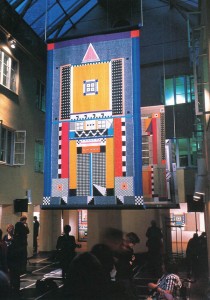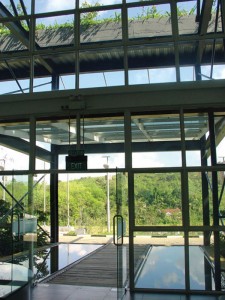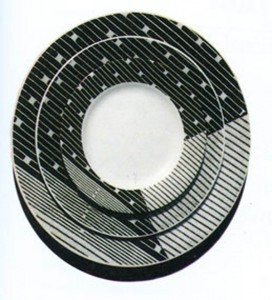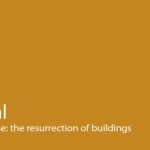-
An Artist Recognised
April 2010
His story begins as a young student, his head leading him in the footsteps of his father the engineer, but his heart walked in the footsteps of the creativity he inherited from his mother; a path that led him into the world of art and architecture. One task a young architecture student had to endeavour in the mid 60’s at the School of Architecture at Katubedda, was to create a collage using lettering from a magazine, a task Tilak found so visually exciting that he engrossed himself in it all through the night.
Tilak Samarawickrema: Architect. Artist. Designer. In no specific order.
A man, whose passion for experimenting and presenting varied modes of art, is astonishing, breathtaking and unique.
“This was a turning point in my life. From then on there was no looking back and I became passionately involved in architecture and design…”
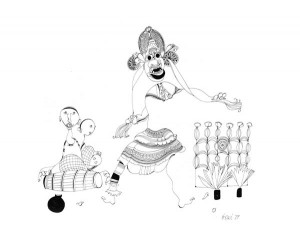 Tilak’s first glimpse at the impermanence of life is as a child, as he watched the Vesak lantern he so lovingly crafted over weeks, burst into flames as the candle inside falls against the fine tissue paper. Perhaps it is the acceptance of this “impermanence” that makes Tilak who he is today; an artist who has identified his style of presentation to be unique and varied.
Tilak’s first glimpse at the impermanence of life is as a child, as he watched the Vesak lantern he so lovingly crafted over weeks, burst into flames as the candle inside falls against the fine tissue paper. Perhaps it is the acceptance of this “impermanence” that makes Tilak who he is today; an artist who has identified his style of presentation to be unique and varied.
His story further strengthens as he is first seen as a young apprentice at Edwards, Reid and Begg working with Geoffrey Bawa, Ulrik Plesner and Valentine Gunasekara.Tilak later discovers the extent of innovation possible in contemporary architecture and joins the State Engineering Cooperation to work with pre-fabricated and pre-stressed structures. A different world and dimension to Tilak’s passion for exploration.
“I was a hungry architecture student – had my tentacles in all arts… not just architecture.”
From illustrations etched on traditional ola leaf manuscripts, to paintings, photography, the performing arts and the diversity of culture and religion, he was inspired and fascinated by its visual content, its compositions, colours; so fascinating, it could not be limited to architecture alone.
“I never imagined the life of an artist. I simply drifted into it when I saw my doodling habit evolve into a serious art form… as my scribbles turned into line drawings, I realised I was developing a unique style.”
From folk rituals and religious festivals and dance recitals, Tilak’s line drawings do not fail to capture the drama and festivity of the event. Just by the graceful movement of his lines on the crisp page, one is able to feel the movement of the subject in his drawing.
Impressed by his portfolio of architectural work and line drawings, the Italian Government offered him a scholarship and in the early 1970’s Tilak arrived in Italy; the world of iconic buildings.
In Milan, Bruno Munari, an acclaimed Italian designer and author of design books, examining Tilak’s work says, “we have a lot to learn from your part of the world.”
From Lanfranco Colombo’s photographic magazine in Italy, to Tilak’s first solo exhibition, he was becoming more and more recognised in the foreign land. After two years in Milan, Tilak moved to Rome, enrolling in the International Centre for Conservation and Preservation of Historic Sites and Monuments. In 1973, after being immensely impressed by Tilak’s work, Jose Antonio Pratt Mayans, a great South American artist and art critique, introduced him to the director of the Bienal de Sao Paulo in Brazil, who in turn invited Tilak to exhibit pieces to represent Ceylon. He was also selected to be part of the Quadriaennale Nazionale of Rome, which focused on “the reputed foreign artists living in Italy” and also did a series of limited edition etchings for art galleries.
 It is by chance that Tilak crosses the Atlantic to New York, and in 1979 is invited to display his work in a two week exhibition at The Rizzoli.
It is by chance that Tilak crosses the Atlantic to New York, and in 1979 is invited to display his work in a two week exhibition at The Rizzoli.
Exactly what was it about a Sri Lankan artist that captured the hearts of foreigners, when they could not even come close to understanding and identifying with the story behind Tilak’s drawings? Ironically, even through all the travel and exposure to a foreign land and lifestyle, Tilak’s drawings remained deeply rooted in the art and culture of his own land.
“The Italians love my drawings… and they love the Sinhala calligraphy… They find it so stylish!”
Tarzi Vittachi, head of the UNFPA, after commissioning Tilak to design the poster for the Annual World Conference to be held in Sri Lanka, says, “he would have a hard time establishing himself as a New York Artist due to the esoteric nature of his work.”
Yes. Tilak’s art was a Sri Lankan identity in a foreign land. It was a nostalgic approach which captured the ancient past through rhythm and pattern. Tilak’s drawings are said to be representations of him, “restless and never still” full of energy and movement!
Tilak’s presentation of art did not stagnate with that only of line drawings, instead it is in Rome where he first experimented, giving his work a temporal dimension through animation, where his drawings of Andare of Sri Lanka brought the Sri Lankan folk characters to life at the Oberhausen Film Festival, which won an award from the Italian Ministry of Cultural Affairs.
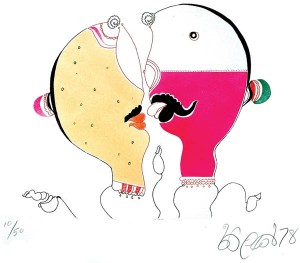
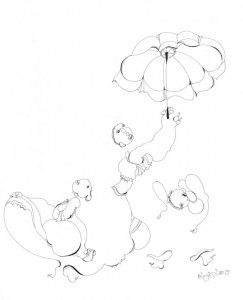
Tilak Samarawickrema’s book, Ink of Lanka “is a story which begins in Sri Lanka and moves to Italy and America and then Italy again, before coming back to Sri Lanka.”
Tilak’s approach to art continues, as when he returns to Sri Lanka, is appointed Design Consultant to the National Design Centre of Sri Lanka in March 1986. Tilak was able to virtually execute a miniature “Bauhaus” with the crafts people of Sri Lanka, centred on reviving waning crafts traditions, to make them meaningful to contemporary markets.
From line drawings all the way to apparel, Tilak is creatively moving forward. His next pronounced mode of art was through rich tapestries, influenced by decorative ceremonial costumes and Sinhalese dancers. To this, Bruno Munari exclaimed,
“….tradition is not something that is behind us, but within us in our thinking, in our way of being, and our expression… He recomposes a new imagery coherent with contemporary sensibility and new technology.”
His tapestries were first exhibited in Milan in 1992, Germany in 1995 and in Oslo in 1998. Tilak’s intricate planned compositions of colour and lines are not limited to walls, but instead have influenced top designers such as FENDI.
“…as an architect, a designer and an artist, Samarawickrema has made his own distinctive mark. Even now, he is always experimenting and exploring new horizons.”
Within this artist is also an architect, his work very different from his art, further enhancing his belief in universality in design. Tilak’s architecture is very contemporary, minimalist and is of strong lines, a complete opposite to the flowing curves of his art.
“Tilak is Ceylon. The traditionalism of his work is not picturesque. It is transcendent, it is true, and keeps with skilfulness its people, identity, not as an adorned corpse, but as a form of life”
– Jose Antonio Pratt Mayans

